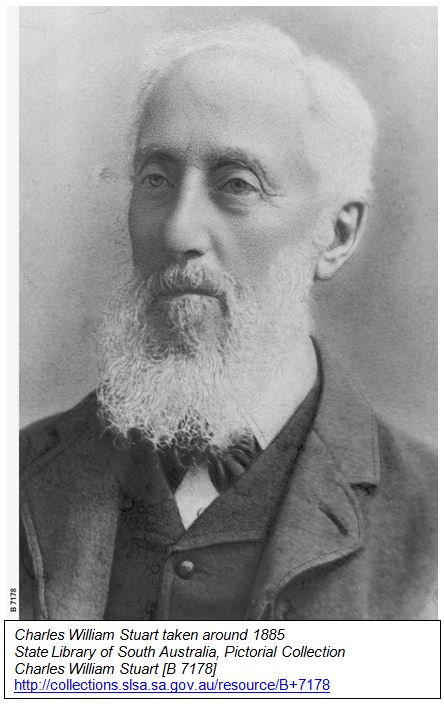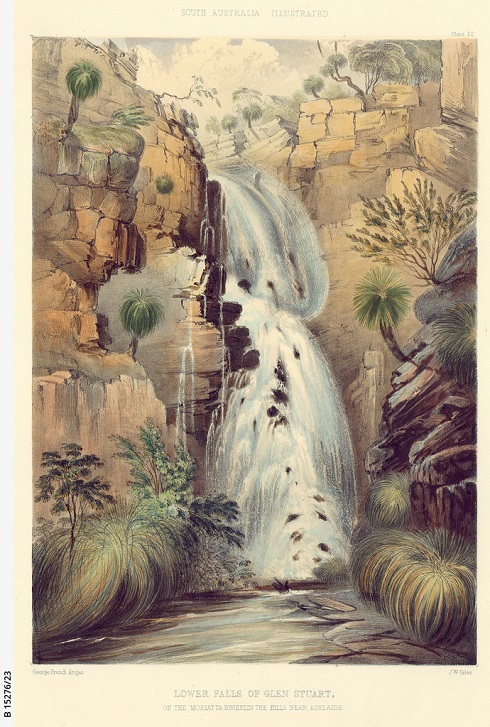Stuart, Charles William
Charles William Stuart was one of the most interesting and enigmatic figures in the history of Campbelltown.
Only a few faint traces of his occupancy remain today, such as the names of Glen Stuart Road on the boundary between Woodforde and Magill, Stuart Street in Rostrevor, and the large Moreton Bay Fig tree in Gurners Reserve, Rostrevor, that is believed to have been planted by him in 1838.
At various times Charles Stuart owned large tracts of land in the Campbelltown area and its immediate surrounds, including all three of the waterfalls in the Morialta Conservation Reserve, then known as the 'Glen Stuart' waterfalls.
Charles Stuart was born in St Marylebone, London in 1812. He was the illegitimate son of Sir Charles Cunningham KCH, an officer in the British Royal Navy in the late Eighteenth and early Nineteenth Centuries, who attained the rank of Rear-Admiral. Charles Stuart's mother, Laetitia Stephens, was married to Captain Charles Stuart RN, and later married Charles Fortnum, an heir to the upmarket Fortnum & Mason department store in Piccadilly, London. Charles Stuart's half-brother, Charles Drury Edward Fortnum, briefly joined him in Adelaide between 1840 - 1845 before becoming a renowned Art collector and a Trustee of the British Museum.

He was educated for three years at Merchant Tailors' School, Suffolk Street, London, and subsequently at a private school at Vauxhall. He at first intended to enter the British Army, but owing to the difficulty of obtaining a commission he withdrew his funds from the army agents.
In September 1833, Charles Stuart left London by the Barque 'Atwick' bound for Sydney via Hobart. After a journey of some five months he arrived in Sydney in February 1834, where he joined a relative, Captain William Caswell RN, at 'Balickara' cattle station near Port Stephens, New South Wales, where he remained for about two years.
Early in 1836, while still living near Port Stephens, NSW, he received from London a land order for a preliminary section of land and a town acre, in a new colony to be called South Australia. This colony was almost unknown in Sydney at the time, and it was with considerable difficulty that he obtained passage to Nepean Bay, Kangaroo Island, on the Schooner 'True Love', which was bound for Swan River, Western Australia.
Charles Stuart was on Kangaroo Island at the time of the arrival of Governor Hindmarsh in December 1836 and he had already entered into the service of the South Australian Company as Manager of Stock by December 5, 1836. After living for a time in makeshift dwellings on the beach near Holdfast Bay (now Glenelg), the South Australian Company had a hut built for him on 'Hallett's old station' in hills above Magill.
According to his extensive diaries, he established his own sheep station in February 1837 "at the foot of the hills", which he called 'No.1 Station'. Then in March, he selected Town Acre No. 316 in Grote Street, Adelaide. Although he never gives an exact location for 'No.1 Station' it was most likely in Rostrevor, as the house that was built for him in Gurners Reserve was known as 'No.1'. However, he did not officially select these Sections of land until May and August 1838, when the land ballots were held.
About the same time Charles Stuart purchased the land that was to become the Morialta Conservation Park. In June 1841 he was listed as the cultivator of 'Glen Stuart' a 100-acre property on the southern side of Fourth Creek along the Morialta Gorge. However, there are signs that Charles Stuart was already over-stretching his resources, as by August 1841 the lower reaches of 'Glen Stuart on the Moriatta Rivulet' were being offered to let, while the upper reaches, including the Third Falls, had been sold to his half-brother CDE Fortnum, who had arrived in 1840.

Lower falls of Glen Stuart
State Library of South Australia B 15276/23
http://collections.slsa.sa.gov.au/resource/B+7178
In 1840, he purchased land in Athelstone and Newton, which he named also named 'Glen Stuart' or 'Glen Stuart under Black Hill'. He later leased the land in Athelstone to the Kidman family, and this is where the famous pastoralist Sir Sidney Kidman was born in 1857.
It is not clear if he ever occupied the hut built for him on 'Hallett's old station' by the South Australian Company, as he only went "to see if the hut was habitable" at the end of June 1838 and then parted ways with the South Australian Company at the beginning of August.
However, he had also had a number of profitable sidelines, including a sawmilling operation in the Tiers or Mount Lofty Ranges. His men built post-and-rail fences around the West Terrace Cemetery, the first Botanic Gardens, the Racecourse and Colonel Light's tomb, among other properties.
On March 5, 1842, Charles William Stuart married Sarah Matilda Allen, third daughter of Mr Thomas Allen of Walkerville, at St John's Church, Adelaide. Once married, they settled into a homestead on the second 'Glen Stuart' or the 'Black Hill Farm' as it was known, near the corner of Maryvale and Montacute Roads in Athelstone. Here they ran cattle, planted wheat, an orchard, vineyard, and vegetable garden.
Charles Stuart continued to speculate in land, purchasing properties at high rates of interest without having the resources to make the land productive, and often losing money in the transactions. Before long he tired of farm life and looked for other ways to earn a living.
In 1850, Charles Stuart was appointed Inspector of the Metropolitan Police, and two years later, during the Victorian gold rush, he was promoted to the position of Senior Inspector of Mounted Police and Gold Escort. During his time with the police force, in addition to escorting gold shipments from the Victorian goldfields, he participated in the capture of some of the notorious bushrangers of the day.
In 1853, he was appointed Commissioner of Police and Police Magistrate for the Colony of South Australia. He held these positions for only a brief period, his retirement from public service being caused by a long-running dispute with Captain Alexander Tolmer KTS, the first Commissioner of Police.
Charles Stuart afterwards went to Victoria, where he remained for a number of years, and for a time he acted as Deputy Sherriff for the Victorian Goldfields under Mr Claude Ferry.
After bearing twelve children his wife, Sarah Stuart, died February 4, 1869, at 'Dorsetta Terrace', Flinders Street, Adelaide, aged 44 years.
Charles Stuart returned to South Australia in about 1886 and settled at Mount Barker, where he resided for three years, before removing to his daughter's residence in Franklin street, Adelaide. He died on June 21, 1891, aged 80 years. In addition to various dignitaries, fourteen mounted police under Sergeant Irwin and Lance-corporal Hewitt attended his funeral at the West Terrace Cemetery, out of respect for their old Inspector.
Researched and compiled by Helen Thiselton. If you have any comments or questions regarding the information in this local history article, please contact the Local History officer on 8366 9357 or hthiselton@campbelltown.sa.gov.au
References
South Australian Chronicle (Adelaide, SA), Saturday 27 June 1891, page 16.
Trove: http://nla.gov.au/nla.news-article91541440
Mount Barker Courier and Onkaparinga & Gumeracha Advertiser (SA), Friday 26 June 1891, page 2.
Trove: http://nla.gov.au/nla.news-article148120143
Evening Journal (Adelaide, SA), Thursday 25 June 1891, page 2.
Trove: http://nla.gov.au/nla.news-article198411823
Express and Telegraph (Adelaide, SA), Tuesday 14 March 899, page 2.
Trove: http://nla.gov.au/nla.news-article209526304
Adelaide Observer (SA), Saturday 18 March 1899, page 42.
Trove: http://nla.gov.au/nla.news-article162357731
South Australian (Adelaide, SA), Tuesday 15 June 1841, page 4.
Trove: http://nla.gov.au/nla.news-article71614792
South Australian (Adelaide, SA), Friday 6 August 1841, page 2.
Trove: http://nla.gov.au/nla.news-article71615089
Evening Journal (Adelaide, SA), Tuesday 9 February 1869, page 2.
Trove: http://nla.gov.au/nla.news-article196724732
Diaries of Charles W Stuart (State Library of South Australia: D 6972(L))
Warburton, Elizabeth (1986) "From the river to the hills: Campbelltown 150 years." The Corporation of the City of Campbelltown, Campbelltown (S. Aust.), pages 171-172, 210-211.
